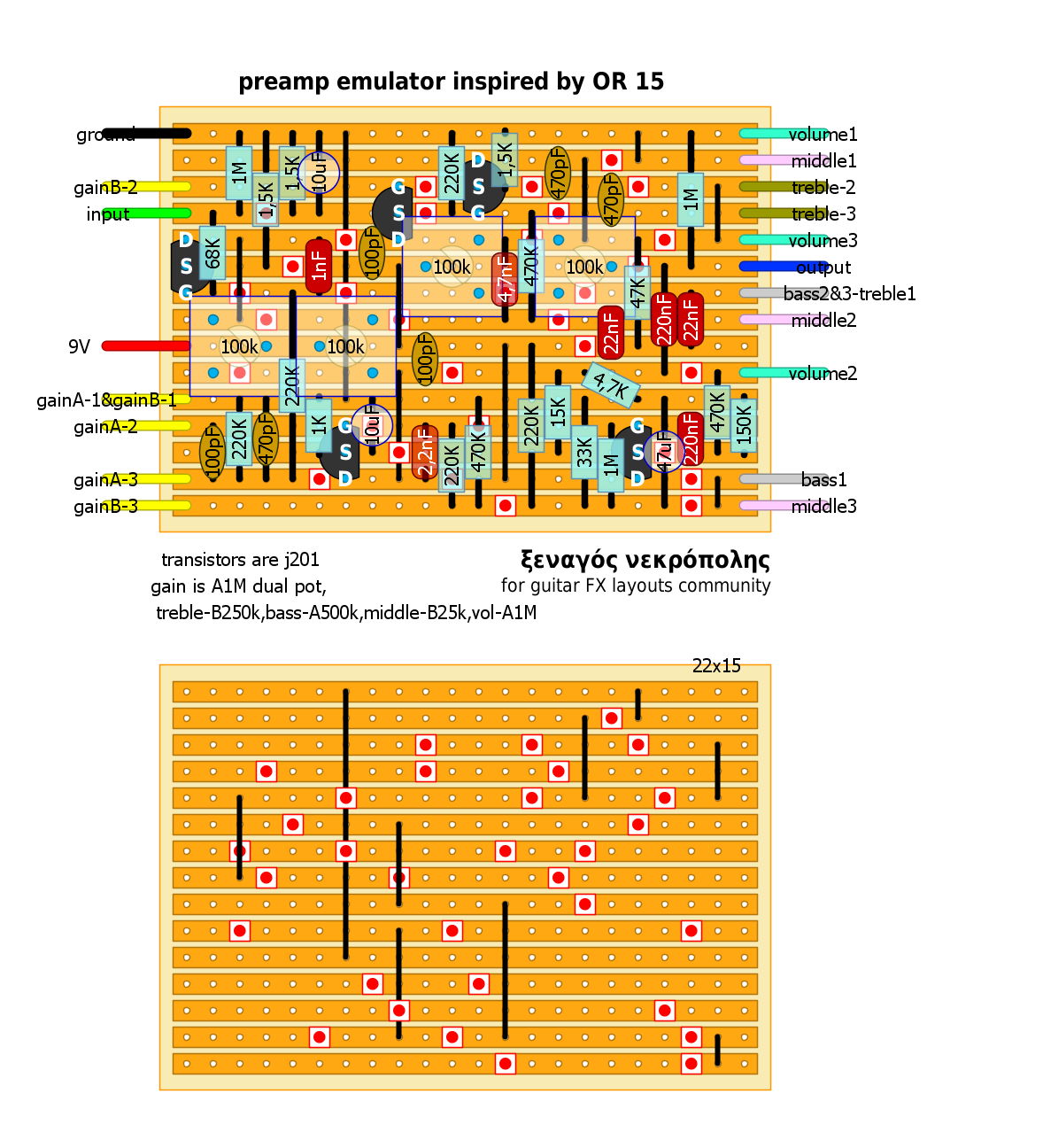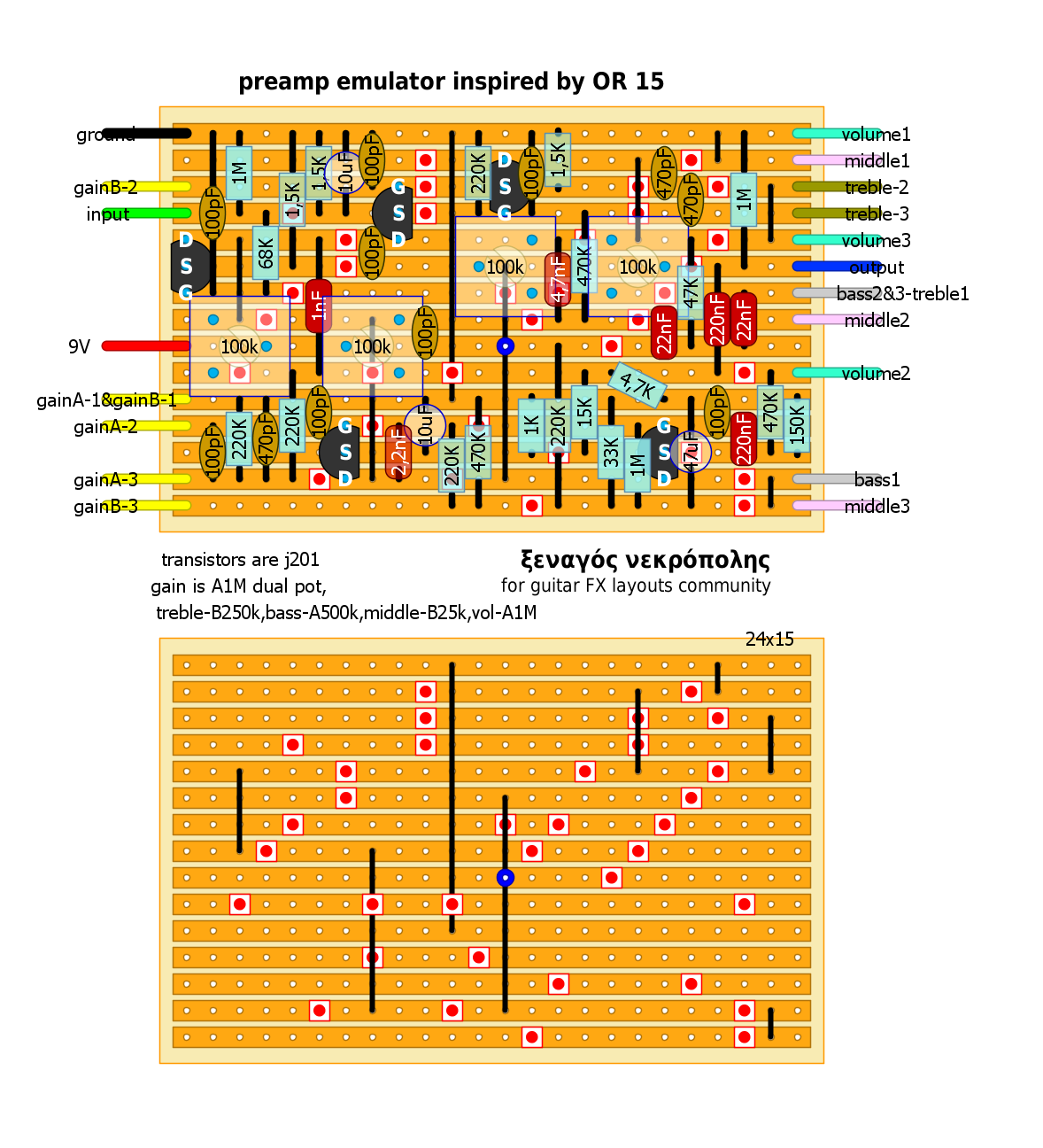An Orange Tiny Terror preamp in a (stomp)box
12














12
An Orange Tiny Terror preamp in a (stomp)box
|
Hi guys, I had the idea of putting the preamp stage of an Orange Tiny Terror or even a Micro or Dark Terror using tagboard, powered by Renegadrian's 555 SMPS that I found on JuanSolo's site, which converts 9v to 190v. Of course this isn't something that can easily fit in a 1590BB, but it might possibly fit in a 6500. And since this pedal will be pretty loud, I think a daughterboard at the end of the circuit with a 25k trim pot would be handy to dial in the max volume.
I might even have the confidence to do my own tagboard layout of this if anyone wants to check my work and make corrections. I just don't have the software for it, so it'll have to be hand drawn. So what do you guys think? Anybody want to help me with this? |
Re: An Orange Tiny Terror preamp in a (stomp)box
|
Actually, I realize that having a high voltage valve pedal isn't really everybody's go-to thing here. But I found the vero layout for the JCM800 under amp emulations on the blog. I don't know enough about transistors though, like what kind to use, how to set the bias, etc. Still learning though.
So how about a Tiny/Dark terror based pedal with JFET's? Anybody? |
|
Terror series emulation would be pretty cool. I have the #4 schematic and OR15 if you'd want to use those for something.
|
Re: An Orange Tiny Terror preamp in a (stomp)box
|
Thanks Squirrels, that would be really cool! I was only looking at Tiny Terror schems but an OR-15 would be fantastic. The thing is I don't know how to substitute tubes for transistors. I wouldn't know which kind to use and what to set their bias at.
|
|
I have an OR15 and modified it to #4 spec for awhile, it's only a difference of three caps and a resistor. I'm trying to make the changes switchable actually, I may need to post something under the amps thread. The OR15 is actually very similar to the Dark Terror when the mids are scooped.
Here's a link to the OR15 schematic: http://music-electronics-forum.com/attachments/27432d1392050035-orange-or15-sch-115v-230v.pdf The changes from the OR15 to Jim Root Terror are as follows: C11 and C12 are 1nF C7 is 4.7n R17 is 39k Can't help you with the transistor substitutions though, sorry. I hope the schematic helps though. |
Re: An Orange Tiny Terror preamp in a (stomp)box
|
i've read this.
http://www.runoffgroove.com/fetzervalve.html i wanted to understand how i could draw this layout using j-fets. no luck. got lost with all these maths and calculations. can someone explain what components we should change around those triodes? and what are those Rs,Rd,Av.....? sorry... but my english are not so good when i have to understand theory |
Re: An Orange Tiny Terror preamp in a (stomp)box
|
Wow that link you provided is a great place for this project to start! I checked it out, and to answer your question: in the example for step 9, Rs is the source resistor, Rd is the drain resistor, Vd is drain voltage. I'd need to read it more extensively before I can even draw a schematic.
|
Re: An Orange Tiny Terror preamp in a (stomp)box
|
In reply to this post by squirrels
can someone suggest what those C,D,E voltage supplies should be from that schematic squirrels uploaded?
i believe we could get this or15 in a box. |
|
I can email someone the Jim Root Terror schematic if someone wanted to take a crack at that one as well. It's basically the same thing as the OR15 with the swaps I posted earlier. Both are essentially 15 watt versions of the Rockerverb 100 but with the OR having a more vintage voiced tone stack.
|
Re: An Orange Tiny Terror preamp in a (stomp)box
|
In reply to this post by ξεναγος νεκροπολης
Hi Savvas.
Most tube amp schematics show those connections at the plates coming from the power transformer secondary after various stages of filtering. In fact you can see the same here (in the centre of the schematic). From what I've been reading, you can ignore all that in a FET conversion and treat those connections as supply (9v). The important things to consider... 1. Remove all cathode bypass caps (C1, C6, C9) 2. Add a low value cap from Grid (Gate) to ground 3. Plate bypass caps (C5 and C8) are used to filter out high frequencies in high gain amps. Experiment with values or omit. All a matter of taste 4. Replace R3 R7 R11 and R15 with 10-20K trimmers for biasing. 5. Work out cathode (Source) resistor values depending on what FETs you intend to use. They don't look far off as they are. That calculator you linked to is great! 6. Adding an input and output cap probably wouldn't hurt 7. The tone section is typical Fender/Marshall but post gain rather than pre. That may well mean there is no recovery section necessary depending on injection loss. 8. The gain pot is dual gang. It may be worth experimenting with 2 separate gain pots like the popular Klon mod for increased flexibility. Hope some of this helps. |
Re: An Orange Tiny Terror preamp in a (stomp)box
|
huge thanks man!
that helped a lot. i knew i should do 4., 5., 7., of those things you suggested, and i remembered from 7. this one that i drew one year ago. http://guitar-fx-layouts.42897.x6.nabble.com/mr-l3ct3r-pre-amp-tp14828.html i've found some similarities that could help. from mr l3ct3r's schem, we can see that they used R14 an R6 to pull down 9volts at some stages. i don't know.maybe i'll try them. also in mr lecter there are cathode/source caps but they are way smaller. and thanks for that gain tip. i haven't heard that klon mod. i'm not a klon fun but i could use some reading on this. i'll check about that. thanks again mate. in the next days we might have a layout.i need to search some things before start drawing. |
Re: An Orange Tiny Terror preamp in a (stomp)box
|
The cathode caps increase the gain of the triode by reducing/removing feedback in a common cathode network like this amp. Removing this cap will reduce the gain, therefore the saturation at each stage. That Lector schematic you linked to has kept the cathode caps to up the gain...but then put some pretty big plate bypass caps in to most likely shave off excessive treble frequencies or kill oscillation.
The hard part in all this will be figuring out how much gain and filtering will be required of each FET to accurately emulate the Orange amp.....without having one beside you to compare sounds. But dammit I'm interested!!! |
|
In reply to this post by Ciaran Haslett
Interesting project! I think you look at the Runoff groove amp-in-a-box design for some tips on how to convert the Orange preamp to a stompbox. Some of my thoughts:
* You may not want to remove all the cathode bypass caps as they greatly affect the gain (usually a factor of 2 or more). My experience with a similar circuit is that it is best to lower or remove the first one, C1 in this case, but keep the others as is. Too much gain on the first JFET stage gives you distorted bass frequencies which sound "farty" to me. * You definitely want trimmers to bias the JFETs given the wide variation in Idss and Vp. However, don't make them all 100K - lower is better (50K is what I normally use, sometimes smaller yet depending on the JFET). * I like the dual gang Gain control in this design. That's one of the things that makes it unique versus other amp sims. * As far as source resistor values are concerned, you can probably keep them as they are for the real amp, especially if you have a source bypass cap. I wouldn't necessarily use the Fetzer source resistor values since they depend entirely on your specific JFET's operating characteristics. On the other hand, an optimal source resistor for any application will likewise depend on the specific JFET. Maybe the approach should be this: if you want to use JFETs in an amp sim, you should sort through your stash and select JFETs that will be the most "tube like" in terms of response and gain, rather than trying to make a design which can accommodate any old JFET. |
|
One more note. I've been reading (again) some of the threads over at DIYStompboxes.com about triode emulation, and they emphasize that you can't just swap a jfet for a triode in an amp schematic and have it sound the same (http://www.diystompboxes.com/smfforum/index.php?topic=93889.0). At best, you can call these ROG-type circuits "inspired-by" emulations. Having said that, I note that lots of pedal makers seem to be favoring mu amp designs these days (e.g. Catalinbread Galileo Mk2). Perhaps an alternative to the simpler common source jfet stage?
|
Re: An Orange Tiny Terror preamp in a (stomp)box
|
take a look.i omitted the first source cap.
all other values are as per the schem. should i lower the other source caps??? i want to hear others thoughts so we can change some values if needed. 
|
Re: An Orange Tiny Terror preamp in a (stomp)box
|
forgot to add small gate caps as Ciaran Haslett suggested.
here it is 
|
|
aah, juicy fruit...
 many thanks for turning this idea into a thing, savvas. could turn out to be mighty, could be horrendous. but (as frank said) it's definitely 'interesting'. am ordering some j201 now. |
Re: An Orange Tiny Terror preamp in a (stomp)box
|
i've just breadboarded it.
it works. it has low output though. it's about 80% of unity gain. also... i just took 5 j201 and through them in. i didn't measured them at all. i took out those 2 100pf Plate bypass caps (C5 and C8). nothing serious happened... used 20k trimpots and bias by ears. to get the highest gain, drains were not even close to 4,5V. but after all as i said i didn't measure my fets at all. this one has potentials to become a really warm effect. so come on guys!any thoughts?first of all i'll measure some fets. (but i'm not good at it...  ) )
do you think that this will help with low output? if not what should i do? |
Re: An Orange Tiny Terror preamp in a (stomp)box
|
Try increasing the source bypass caps. That'll increase the gain of each stage. Maybe add one back into the first stage. Plate caps will only adjust frequency content. Try bypassing the tone stack and see how it affects the overall volume. It's possible the injection loss is affecting the volume. If that's the case, try adding a recovery stage, either FET, or BJT like the LPB1. I'm on my phone atm but I'll get a better look when I get back to my computer. Oh......Great work man! This project is really yours. I vote we change the name to The Tiny Trojan or the Trojan Terror to reflect its maker Sent from my iPhone
|
Re: An Orange Tiny Terror preamp in a (stomp)box
|
increased all source bypass caps(including the first stage)
used 22μf,47μf, and 100μf. i think i've reached unity gain, but too much distortion added. i've bypassed the tone stack and OMG!!!!! real power there! i took my output from 47k at the right of the 4th trimmer. tones of volume. can't understand how this eq system drops the volume so much. i'll try to fix those volume issues with your suggestions of course! And Ciaran. thanks man! you and Frank helped a lot. i probably wouldn't go so far on this one without your inputs! so thank you both! i believe that this one is really ours.it's just that i breadborded first! cheers  Savvas |
«
Return to Amp in a Box & Cab Sims
|
1 view|%1 views
| Free forum by Nabble | Edit this page |


 )
)